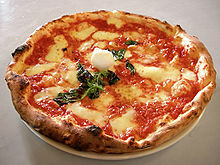- New York-style pizza
-
part of a series on Pizza  Main articlesPizza varietiesCalifornia-style pizza · Chicago-style pizza · Detroit-style pizza · Greek pizza · Hawaiian pizza · Mexican pizza · New Haven-style pizza · New York-style pizza · pastrmajlija · pizza al taglio · Sicilian pizza · tomato pie · St. Louis-style pizzaSimilar dishesDeep-fried pizza · grilled pizza · pizza bagel · calzone · coca · cong you bing · farinata · flammkuchen · focaccia · garlic fingers · lahmacun · manakish · paratha · pissaladière · quesadilla · sardenara · sausage bread · stromboliPizza tools
Main articlesPizza varietiesCalifornia-style pizza · Chicago-style pizza · Detroit-style pizza · Greek pizza · Hawaiian pizza · Mexican pizza · New Haven-style pizza · New York-style pizza · pastrmajlija · pizza al taglio · Sicilian pizza · tomato pie · St. Louis-style pizzaSimilar dishesDeep-fried pizza · grilled pizza · pizza bagel · calzone · coca · cong you bing · farinata · flammkuchen · focaccia · garlic fingers · lahmacun · manakish · paratha · pissaladière · quesadilla · sardenara · sausage bread · stromboliPizza toolsNew York-style pizza originated in New York City in the early 1900s. It is known for its large, wide, thin and foldable shape. The traditional toppings were tomato sauce and mozzarella cheese, with any additional toppings placed with the cheese. It is traditionally hand-tossed and light on sauce. The slices are often eaten as a 'street snack' while folded in half, as its size and flexibility sometimes makes it unwieldy to eat flat.
The most notable difference between New York style and other American pizzas is its thin hand-tossed crust, made from a high-gluten bread flour. The flavor of the crust has sometimes been attributed to the minerals present in the New York City water used to make the dough.[1] Some out-of-state pizza makers even transport the water cross-country for the sake of authenticity.[2][3] New York-style pizza is usually sold both by the slice and as whole pies. Slices are taken from a large pie — typically around 18 inches (45 cm) in diameter — and most commonly cut into 8 slices. Pizzas to be sold by the slice can be either "plain" (sometimes "cheese" or "regular" ) or with toppings. While many New York pizzerias also have slices with various toppings ready to serve, they invariably have plain slices ready to go, and can provide slices with toppings by adding them on prior to re-heating.
New York pizzerias generally have condiments that can be added to the pizza after serving. Common condiments include oregano, grated Parmesan cheese, dried red chili pepper and garlic powder.
Also served in the New York area, square-shaped slices with much thicker dough are called Sicilian slices, though they often differ considerably from the true pizza of Sicily. In some cases at shops offering both, normal (thin crust) New York style is distinguished as Neapolitan pizza although the relationship is distant.
Relatives and regional variation
This style of pizza (or at least close relatives to it) tends to dominate the Northeastern states, with many shops advertising New York-style pizza. It is sometimes also known as "Italian pizza" (as opposed to Greek pizza) since it reflects the variety of pizza made most commonly in Italian-American-owned pizza shops. Many stores in Toronto have developed this style.
Outside of the Northeast, many pizzas are described as "New York style" - including some by major pizza chains such as Pizza Hut. Authenticity is highly variable and often spurious; as the term is often misapplied to "generic American" pizza - examples would be crust that is too thick (or too cracker-like) or the use of mixed multi-cheese blends (especially containing cheddar.)
 Lombardi's Pizza at 32 Spring Street in Little Italy, Manhattan
Lombardi's Pizza at 32 Spring Street in Little Italy, Manhattan
The first pizzeria in the United States was opened in 1905 by Gennaro Lombardi, at Lombardi's in Little Italy, Manhattan.[4]
References
- ^ Gilbert, Sara. "New York Pizza: is the water the secret?". Slashfood. Weblogs, Inc.September 26, 2005.
- ^ Cornwell, Rupert. "New York's 'Champagne Tap Water' Under Threat". The Independent UKJuly 21, 2006.
- ^ Wayne, Gary. "Mulberry Street Pizzeria". Seeing Stars in Hollywood. 2008.
- ^ Asimov, Eric (June 10, 1998), "New York Pizza, the Real Thing, Makes a Comeback", New York Times, http://www.nytimes.com/1998/06/10/dining/new-york-pizza-the-real-thing-makes-a-comeback.html, retrieved September 24, 2006
External links
Categories:- American pizza
- Cuisine of New York City
- Culture of New York City
Wikimedia Foundation. 2010.

